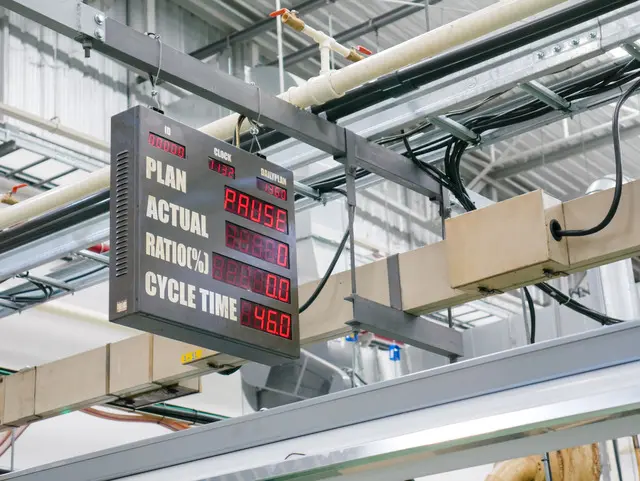Humanizing Safety Data Sheet (SDS) Management with Automation
In the bustling world of manufacturing, ensuring the safety of employees and the environment is paramount. Amidst the complex operations, managing Safety Data Sheets (SDSs) can often become a tedious and error-prone task. Safety Data Sheet (SDS) Management Automation emerges as a game-changer, empowering manufacturers to streamline this critical process, ensuring accuracy, efficiency, and compliance.
Harnessing the power of Python, AI, and cloud-based solutions, Safety Data Sheet (SDS) Management Automation automates the distribution and update notifications for relevant safety data sheets. By automating these tasks, manufacturers can significantly reduce the risk of human error, improve communication, and enhance overall workplace safety.

Python, AI, and the Cloud: Empowering Safety Data Sheet (SDS) Management Automation
Python, a versatile programming language, plays a pivotal role in developing both unattended and attended bots for Safety Data Sheet (SDS) Management Automation.
Unattended Bots: Python’s robust capabilities enable the creation of unattended bots that can autonomously handle repetitive tasks, such as extracting data from SDSs, generating reports, and triggering notifications. These bots can operate 24/7, ensuring uninterrupted processing and timely distribution of safety information.
Attended Bots: Python’s flexibility allows for the development of attended bots that assist human users in completing tasks. These bots can provide real-time guidance, automate data entry, and perform complex calculations, enhancing the efficiency and accuracy of SDS management processes.
Cloud platforms offer a comprehensive suite of features and capabilities that surpass traditional RPA/workflow tools orchestrators. They provide scalable infrastructure, built-in security measures, and access to advanced AI services.
AI techniques, such as image recognition, natural language processing (NLP), and generative AI, can significantly enhance the accuracy and effectiveness of Safety Data Sheet (SDS) Management Automation. These techniques enable automation systems to:
- Extract data from complex and unstructured SDS documents
- Classify and categorize SDSs based on content
- Identify and flag potential hazards and inconsistencies
- Generate tailored safety recommendations and instructions
By leveraging the power of Python, AI, and cloud platforms, manufacturers can unlock the full potential of Safety Data Sheet (SDS) Management Automation, ensuring a safer and more efficient work environment.

Building the Safety Data Sheet (SDS) Management Automation with Python and Cloud
The Safety Data Sheet (SDS) Management Automation process involves several key subprocesses:
Data Extraction: Python’s powerful data extraction capabilities can be leveraged to extract relevant information from SDS documents, such as chemical hazards, handling instructions, and emergency procedures.
Data Classification: Using machine learning algorithms integrated with the cloud platform, SDSs can be automatically classified and categorized based on their content, ensuring proper handling and storage.
Distribution and Notification: Automated workflows can be established to distribute SDSs to relevant personnel and trigger notifications for updates or changes. This ensures that employees always have access to the most up-to-date safety information.
Compliance Management: The automation system can track and monitor SDS-related activities, ensuring compliance with regulatory requirements and industry best practices.
Python’s robust security features and the cloud platform’s compliance certifications guarantee the secure handling and storage of sensitive SDS data.
Advantages of Python over No-Code RPA/Workflow Tools:
- Customization: Python allows for highly customized automation solutions tailored to specific business needs, unlike pre-built RPA tools.
- Scalability: Python-based automations can easily scale to handle large volumes of SDSs and complex workflows.
- Integration: Python seamlessly integrates with various cloud services and third-party applications, enabling end-to-end automation.
Algorythum’s Python-based approach empowers manufacturers to overcome the limitations of off-the-shelf automation platforms and achieve truly transformative Safety Data Sheet (SDS) Management Automation.

The Future of Safety Data Sheet (SDS) Management Automation
The future of Safety Data Sheet (SDS) Management Automation holds exciting possibilities, with emerging technologies poised to further enhance its capabilities.
- Blockchain Integration: Blockchain technology can provide a secure and immutable ledger for tracking SDS distribution and ensuring data integrity.
- Augmented Reality (AR): AR applications can overlay safety information onto physical assets, providing real-time guidance to employees.
- Predictive Analytics: Machine learning algorithms can analyze historical data to predict potential safety risks and identify areas for improvement.
Subscribe to our newsletter to stay updated on the latest advancements in Safety Data Sheet (SDS) Management Automation and other industry-specific automation solutions.
Contact our team today for a free feasibility assessment and cost estimate tailored to your specific requirements. Together, we can unlock the full potential of automation and create a safer and more efficient workplace.

Algorythum – Your Partner in Automations and Beyond
At Algorythum, we specialize in crafting custom RPA solutions with Python, specifically tailored to your industry. We break free from the limitations of off-the-shelf tools, offering:
- A team of Automation & DevSecOps Experts: Deeply experienced in building scalable and efficient automation solutions for various businesses in all industries.
- Reduced Automation Maintenance Costs: Our code is clear, maintainable, and minimizes future upkeep expenses (up to 90% reduction compared to platforms).
- Future-Proof Solutions: You own the code, ensuring flexibility and adaptability as your processes and regulations evolve.









